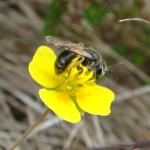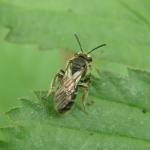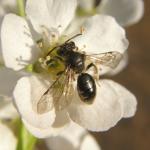Throughout much of Britain and Ireland, though apparently absent from the Channel Islands. The bee is often locally common but is readily confused with its close relative Andrena minutula (Kirby).
The species has a Eurasian range, occurring from western Europe to Japan and Kamchatka (Tadauchi, 1985; Gusenleitner & Schwarz, 2002).
This species is not regarded as scarce or threatened.
The species occurs in various habitats but is perhaps most closely associated with open deciduous woodland.
Generally regarded as univoltine, flying from April to June. However, there are a few authentic summer records from June to September. These may represent a partial second brood.
Nests are rarely encountered. Kocourek (1966) and Westrich (1989) describe the species as nesting in small aggregations in sparsely grassed banks.
A wide range of species have been recorded: buttercup, lesser stitchwort, a willow, a cabbage, bilberry, tormentil, trailing tormentil, a strawberry, hawthorn, a spurge, small-flowered crane’s-bill, a water-dropwort, germander speedwell, sheep’s-bit, a dandelion, daisy, oxeye daisy, a squill.
Nomada flavoguttata (Kirby) is a cleptoparasite of this species. Individuals are occasionally stylopised by Stylops spreta Perkins (Strepsiptera).
2016




